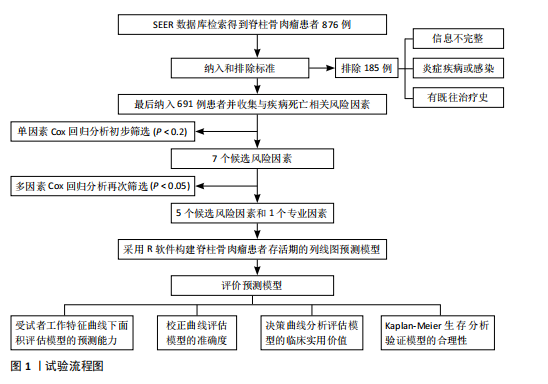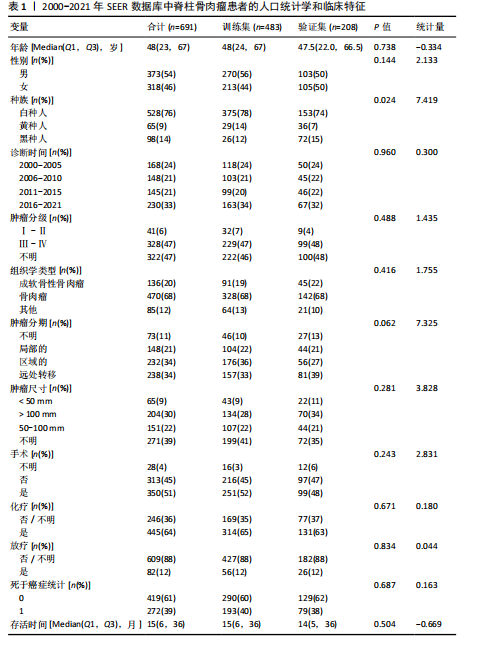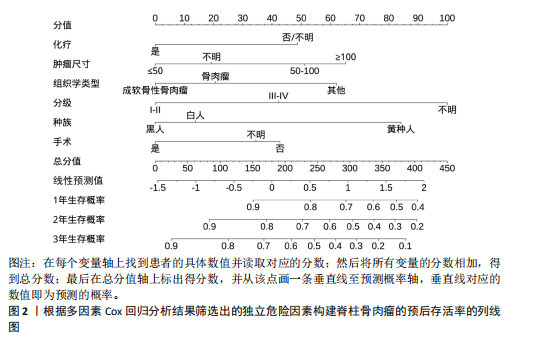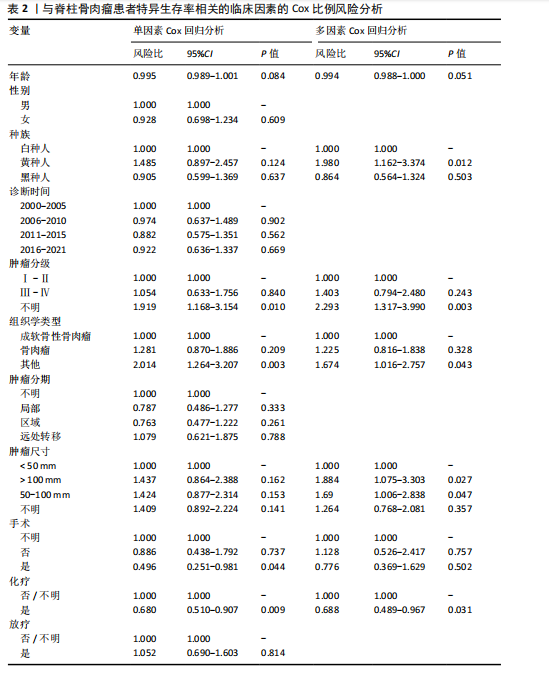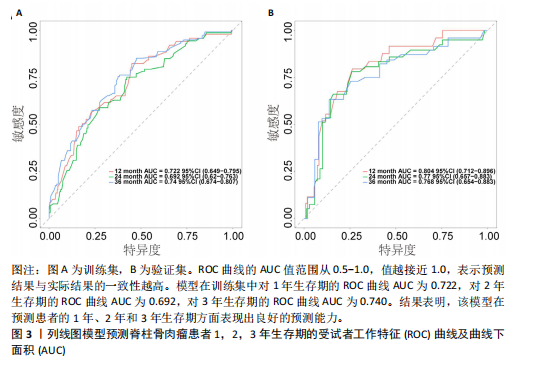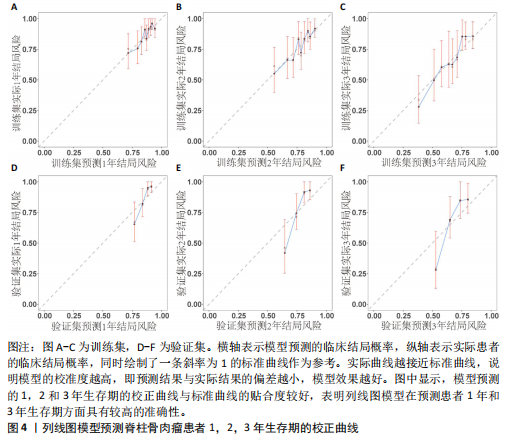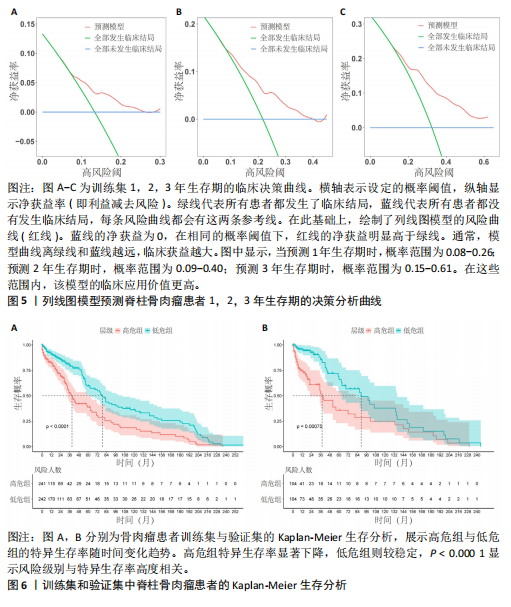[1] HUANG Z, HUANG C, WANG Y, et al. Clinical Features, Risk Factors, and Prediction Nomogram for Primary Spinal Osteosarcoma: A Large-Cohort Retrospective Study. Global Spine J. 2024; 14(3):930-940.
[2] MATHKOUR M, GARCES J, BEARD B, et al. Primary High-Grade Osteosarcoma of the Clivus: A Case Report and Literature Review. World Neurosurg. 2016;89(730):9-13.
[3] ZHONG W, LUO W, LIN Z, et al. Prognostic analysis of telangiectatic osteosarcoma of the extremities. Front Oncol. 2022;12:1105054. doi: 10.3389/fonc.2022.1105054.
[4] 元耀博, 李甲振, 张岩, 等. 影响Ⅰ级软骨肉瘤手术切除预后的因素[J]. 中国矫形外科杂志,2021,29(13):1199-1204.
[5] BIELACK SS, WULFF B, DELLING G, et al. Osteosarcoma of the trunk treated by multimodal therapy: experience of the Cooperative Osteosarcoma study group(COSS). Med Pediatr Oncol. 1995; 24(1):6-12.
[6] GILL J, GORLICK R. Advancing therapy for osteosarcoma. Nat Rev Clin Oncol. 2021; 18(10):609-624.
[7] WU J, SUN H, LI J, et al. Increased survival of patients aged 0-29 years with osteosarcoma: A period analysis, 1984-2013. Cancer Med. 2018;7(8):3652-3661.
[8] 郭卫. 中国骨盆恶性肿瘤保肢治疗30年的发展与进步[J]. 中国修复重建外科杂志,2022,36(7):781-789.
[9] GROVES ML, ZADNIK PL, KALOOSTIAN P, et al. Epidemiologic, functional, and oncologic outcome analysis of spinal sarcomas treated surgically at a single institution over 10 years. Spine J. 2015;15(1):110-114.
[10] 武壮壮, 吕智, 李立志, 等. 同时型多发骨肉瘤一例报告及系统文献复习[J]. 中华骨科杂志,2020,40(22):1557-1566.
[11] ZHENG S, CHEN L, WANG J, et al. A clinical prediction model for lung metastasis risk in osteosarcoma: A multicenter retrospective study. Front Oncol. 2023;13:1001219.
[12] MENG J, DU H, LU J, et al. Construction and validation of a predictive nomogram for ferroptosis-related genes in osteosarcoma. J Cancer Res Clin Oncol. 2023;149(15): 14227-14239.
[13] 陈海妹, 刘金, 程梓轩, 等. 基于多中心T_1WI影像组学列线图治疗前预测骨肉瘤一年内复发的价值[J]. 中华放射学杂志,2020,54(9):874-881.
[14] SIEGEL RL, MILLER KD, FUCHS HE, et al. Cancer Statistics, 2021. CA Cancer J Clin. 2021;71(1):7-33.
[15] YANG X, YANG Y, WENG X, et al. Nomogram for predicting disease-specific survival in osteosarcoma. Chin Med J(Engl). 2022; 135(9):1126-1128.
[16] KELLEY SP, ASHFORD RU, RAO AS, et al. Primary bone tumours of the spine: a 42-year survey from the Leeds Regional Bone Tumour Registry. Eur Spine J. 2007;16(3): 405-409.
[17] 梁积铭, 谢天裕, 罗恺, 等. 骨肉瘤淋巴结转移的研究进展[J]. 中华骨科杂志, 2023,43(20):1402-1408.
[18] 袁源, 王晨曦, 叶凯, 等. 基于CT的影像组学在鉴别脊柱骨肉瘤与软骨肉瘤中的价值[J]. 临床放射学杂志,2024,43(8): 1384-1387.
[19] ANWAR MA, EL-BABA C, ELNAGGAR MH, et al. Novel therapeutic strategies for spinal osteosarcomas. Semin Cancer Biol. 2020;64:83-92.
[20] DO KH, NGUYEN TV, HOANG TT, et al. Histopathological Response to Neoadjuvant Chemotherapy in Patients With Enneking Stage II Conventional Osteosarcoma of Extremities: A Retrospective-Single Institution Study in Vietnam. Cancer Control. 2024;31:10732748241274188.
[21] HUANG Z, ZHAO Z, WANG Y, et al. Clinical characteristics, prognostic factors, and predictive model for elderly primary spinal tumor patients who are difficult to tolerate surgery or refuse surgery. Front Oncol. 2022;12:991599.
[22] FENG L, CHEN Y, YE T, et al. Development and validation of an online prognostic nomogram for osteosarcoma after surgery: a retrospective study based on the SEER database and external validation with single-center data. Transl Cancer Res. 2022; 11(9):3156-3174.
[23] OITMENT C, BOZZO A, MARTIN AR, et al. Primary sarcomas of the spine: population-based demographic and survival data in 107 spinal sarcomas over a 23-year period in Ontario, Canada. Spine J. 2021;21(2):296-301.
[24] CHEN B, ZENG Y, LIU B, et al. Risk Factors, Prognostic Factors, and Nomograms for Distant Metastasis in Patients With Newly Diagnosed Osteosarcoma: A Population-Based Study. Front Endocrinol(Lausanne). 2021;12:672024.
[25] FU P, SHI Y, CHEN G, et al. Prognostic Factors in Patients With Osteosarcoma With the Surveillance, Epidemiology, and End Results Database. Technol Cancer Res Treat. 2020;19:1533033820947701.
[26] 王壮壮, 任欢, 刘彦廷, 等. 基于SEER数据库使用列线图对四肢骨肉瘤发生肺转移风险预测模型的构建与验证[J]. 临床荟萃,2024,39(5):413-419.
[27] PILLAI SS. Long-term survival following resection of extracompartmental osteosarcoma of the spine - A case report and literature review. Surg Neurol Int. 2021;12:545.
[28] QI L, REN X, LIU Z, et al. Predictors and Survival of Patients with Osteosarcoma After Limb Salvage versus Amputation: A Population-Based Analysis with Propensity Score Matching. World J Surg. 2020;44(7): 2201-2210.
[29] POMBO B, CRISTINA FERREIRA A, CARDOSO P, et al. Clinical effectiveness of Enneking appropriate versus Enneking inappropriate procedure in patients with primary osteosarcoma of the spine: a systematic review with meta-analysis. Eur Spine J. 2020;29(2):238-247.
[30] 李杰, 陈雷, 胡伦灯, 等. 脊柱转移瘤和转移性脊髓压迫:英国国家卫生与临床优化研究所(NICE)2023指南解读[J]. 中国修复重建外科杂志,2024,38(9):1035-1039.
[31] CHEN Y, GOKAVARAPU S, SHEN Q, et al. Head and Neck Osteosarcoma: Perineural Invasion is Associated With Disease-Free Survival and Tumor Metastasis. J Oral Maxillofac Surg. 2024;82(8):992-998.
[32] GAO B, WANG MD, LI Y, et al. Risk stratification system and web-based nomogram constructed for predicting the overall survival of primary osteosarcoma patients after surgical resection. Front Public Health. 2022;10:949500.
[33] LIAN Q, CHEN F, SHA Z, et al. Disulfiram Upgrades the Radiosensitivity of Osteosarcoma by Enhancing Apoptosis and P53-Induced Cell Cycle Arrest. Radiat Res. 2024;202(5):752-764.
[34] FERRENA A, WANG J, ZHANG R, et al. SKP2 Knockout in Rb1/p53-Deficient Mouse Models of Osteosarcoma Induces Immune Infiltration and Drives a Transcriptional Program with a Favorable Prognosis. Mol Cancer Ther. 2024;23(2):223-234.
[35] SABA KH, DIFILIPPO V, STYRING E, et al. CDK4 is co-amplified with either TP53 promoter gene fusions or MDM2 through distinct mechanisms in osteosarcoma. NPJ Genom Med. 2024;9(1):42.
|
